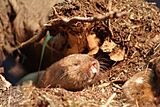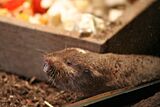Ansell's mole-rat facts for kids
Quick facts for kids Ansell's mole-rat |
|
|---|---|
 |
|
| Conservation status | |
| Scientific classification | |
| Genus: |
Fukomys
|
| Species: |
anselli
|
| Synonyms | |
|
Cryptomys anselli |
|
The Ansell's mole-rat (Fukomys anselli) is a small rodent that lives underground. It belongs to a group of animals called the Bathyergidae family. This special mole-rat is found only in Zambia, a country in Africa. It lives in wet savanna grasslands and miombo forests.
Ansell's mole-rats are famous for building incredibly long tunnels. A single group of about ten mole-rats can dig tunnels up to 2.8 kilometers (about 1.7 miles) long! These animals live in a unique social system. It is called a eusocial system, which means they live in a highly organized family group. In each group, there is a main king and queen who are the only ones that have babies. They are thought to stay together for life.
Amazing Underground Homes
Ansell's mole-rats are expert diggers. They use their special body parts to create their homes deep under the ground. They have a strong body shape, sharp front teeth like chisels, and big jaws. These features help them dig through the soil easily.
Their long tunnels are not just straight paths. They often branch off into different levels underground. This allows the mole-rats to create many different spaces. They use these spaces for important things like finding plants to eat. They also make special areas to store food. Sometimes, they even use these tunnels to communicate with other mole-rat families nearby.
Brain Power of Mole-Rats
Even though Ansell's mole-rats live underground, their brains are similar to other rodents. However, there are some interesting differences. The part of their brain that handles touch, called the somatosensory cortex, is much bigger. This larger area takes up space that is usually used for seeing in animals that live above ground.
This makes sense because mole-rats rely more on touch than sight in their dark tunnels. Also, the part of their brain that handles vision is smaller. But it is actually stronger than in other similar rodents. This means they can still use their sight, even if it is not their main sense.





